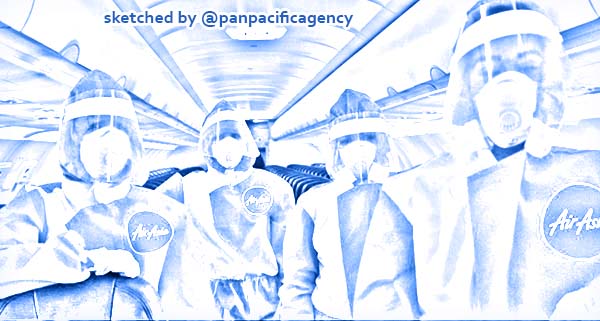[Analytics] PPE chic takes off at Asia’s trend-setter airlines

AirAsia crew members in their new red hot PPE chic costumes. Photo: AirAsia. Sketched by the Pan Pacific Agency.
Couturier Puey Quiñones is on the cutting edge of what he terms “fashion for calamity”, a pandemic-inspired trend that is fast sweeping airlines worldwide. Karen Emmons specially for the Asia Times.
The Los Angeles-based fashion designer recently kitted out AirAsia’s flight crew in Formula One-inspired red and white personal protective equipment, or PPE, completed with a drawstring hood and elastic-cuffed jacket and pants.
He is not the only designer, nor is AirAsia the only airline, adapting to the “Covid-19 season”, as Philippine Airlines called it when showcasing its new Covid-19 protective look for flight attendants by Filipino courtier Edwin Tan.
Although regular flights have yet to resume, Philippine Airlines, known as PAL, hastily created its white PPE suits, with its flag logo patched to the shoulder on the non-porous white fabric for the crews making repatriation flights.
The Philippine crews are also wearing hair nets, face masks, plastic face shields and gloves. Judging by some of the comments on PAL’s Facebook page, one crew’s new protective look may be some passengers’ nightmare.
“I wonder who the genius is at PAL who thinks passengers will feel comfortable flying in their cabin turned into a Covid-19 hospital Intensive Care Unit?” wrote Pete de Leon. “I have an idea, how about PAL buy a UV light disinfecting machine!”
Without doubt, the aviation and wider travel industry must embark on a new era of portable protection. Along with their passport and 100 milliliter bottles, travelers these days will also likely need layers of protection to travel, including masks, gloves and perhaps even HAZMAT suits.
But what of the flight crews who will greet and serve the multitudes of travelers, albeit far fewer due to seat spacing and reduced numbers of flights on any given day?
Just as the race is on for treatment and vaccines, so too is there a race to find a comfortable balance between reassurance and Covid-assurance for airline crew uniforms.
Emirates appears to be going for the middle ground with a transparent disposable dress-length gown for crew and airport staff to wear over their uniforms, with portions of the body still exposed.
The Dubai-based airline’s crew members are now also wearing an abbreviated safety visor in addition to masks and gloves.
With blue gowns and gloves, goggles and face masks that appear straight out of a hospital emergency room, China Airlines clearly has shifted into front-line protection of both crews and passengers.
But will the new PPE chic fly?
“You cannot wear a mask in flight,” insists a Lufthansa attendant stranded in Bangkok, who bought a face shield she hopes to wear when her shift resumes. “You are breathing in your own CO2 and it will make you sleepy and dizzy.”
She not only wonders about “mask bruising” when high altitude air pressure forces the body to expand, she also worries how the “guests” (Lufthansa’s approach to passengers) will feel when they can’t see crew members’ facial reassurance during unexpected turbulence.
“We’re like actors on a stage—all eyes are on us. But if our face is covered?” She also says the crew want to wear gloves, but they don’t want guests to feel they are perceived as “disgusting.”
Crew members with Etihad Airways, KLM, Singapore Airlines, United Airlines and Delta Air Lines will all be wearing face masks or “face coverings”, according to their online safety pronouncements.
Many airlines will be blocking off middle seats for social distancing, flying fewer people per flight and even adjusting food and beverage distribution as part of “temporary changes” noted on their websites.
Delta Air also will be boarding passengers 10 at a time. Water bottles and pre-packaged meals will replace the bar service and pillows and blankets will no longer be available on some Air Canada flights.
Thermal scanners have been installed in airports and sticking distance markers on waiting area floors worldwide. Emirates recently erected protective barriers at check-in desks for its staff to sit behind.
Many airlines also will be requiring passengers to wear masks. Other airlines, such as Delta Air, “are strongly encouraging our customers to wear masks and will make them available at ticket counters, gates and onboard airplanes”, reportedly according to a staff memo.
Beginning last week, American JetBlue airlines requires all passengers as well as crew members to use a face covering during their travels.
“Wearing a face covering isn’t about protecting yourself it’s about protecting those around you,” said Joanna Geraghty, president and chief operating officer of JetBlue in a media statement. “This is the new flying etiquette.”
Airlines’ websites suggest the new PPE etiquette and attire are only “temporary”, until apparently a Covid-19 vaccine and treatments are found and widely distributed. But that may be wishful thinking.
The AirAsia customized PPE uniforms that leave little of the crew members exposed are reportedly only a trial run, with a spokesperson for the Malaysian low-cost airline noting “a further assessment of the design is under way”.
PAL has also suggested that its hastily but stylishly designed white PPE uniforms may also be only temporary.
“The cabin crew uniform for flights this ‘Season’ will showcase various looks, designs and colors,” PAL’s Facebook page reads. “Eventually, a single, branded ‘look’ will fill up our flights this ‘Season’. Stay tuned!”